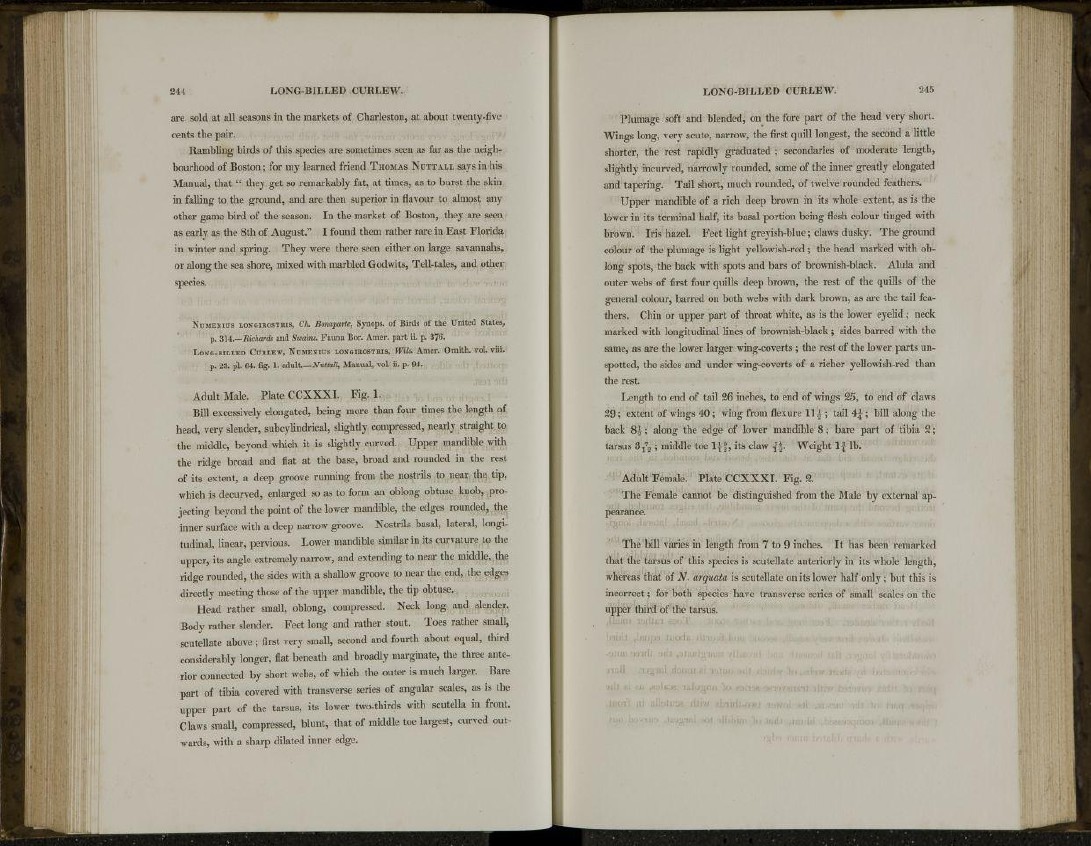
are sold at all seasons in the markets of Charleston, at about twenty-five
cents the pair.
Rambling birds of this species are sometimes seen as far as the neighbourhood
of Boston; for my learned friend THOMAS NOTTALL says in his
Manual, that " they get so remarkably fat, at times, as to burst the skin
in falling to the ground, and are then superior in flavour to almost any
other game bird of the season. In the market of Boston, they are seen
as early as the 8th of August.'" I found them rather rare in East Florida
in winter and spring. They were there seen either on large savannahs,
or along the sea shore, mixed with marbled Godwits, Tell-tales, and other
species.
NUMENIUS LONGIROSTRIS, Ch. Bonaparte, Synops. of Birds of the United States,
p. 314.—Richards and Swains. Fauna Bor. Amer. part ii. p. 376.
LONG-BILLED CURLEW, NUMENIUS LONGIROSTRIS, Wils. Amer. Ornith. vol. viii.
p. 23. p'l. 64. fig. 1. adult Nuttall, Manual, vol. ii. p. 94.
Adult Male. Plate CCXXXI. Fig. 1.
Bill excessively elongated, being more than four times the length of
head, very slender, subcylindrical, slightly compressed, nearly straight to
the middle, beyond which it is slightly curved. Upper mandible with
the ridge broad and flat at the base, broad and rounded in the rest
of its extent, a deep groove running from the nostrils to near the tip,
which is decurved, enlarged so as to form an oblong obtuse knob, projecting
beyond the point of the lower mandible, the edges rounded, the
inner surface with a deep narrow groove. Nostrils basal, lateral, longitudinal,
linear, pervious. Lower mandible similar in its curvature to the
upper, its angle extremely narrow, and extending to near the middle, the
ridge rounded, the sides with a shallow groove to near the end, the edges
directly meeting those of the upper mandible, the tip obtuse.
Head rather small, oblong, compressed. Neck long and slender.
Body rather slender. Feet long and rather stout. Toes rather small,
scutellate above; first very small, second and fourth about equal, third
considerably longer, flat beneath and broadly marginate, the three anterior
connected by short webs, of which the outer is much larger. Bare
part of tibia covered with transverse series of angular scales, as is the
upper part of the tarsus, its lower two-thirds with scutella in front.
Claws small, compressed, blunt, that of middle toe largest, curved outwards,
with a sharp dilated inner edge.
Plumage soft and blended, on the fore part of the head very short.
Wings long, very acute, narrow, the first quill longest, the second a little
shorter, the rest rapidly graduated ; secondaries of moderate length,
slightly incurved, narrowly rounded, some of the inner greatly elongated
and tapering. Tail short, much rounded, of twelve rounded feathers.
Upper mandible of a rich deep brown in its whole extent, as is the
lower in its terminal half, its basal portion being flesh colour tinged with
brown. Iris hazel. Feet light greyish-blue; claws dusky. The ground
colour of the plumage is light yellowish-red ; the head marked with oblong
spots, the back with spots and bars of brownish-black. Alula and
outer webs of first four quills deep brown, the rest of the quills of the
general colour, barred on both webs with dark brown, as are the tail feathers.
Chin or upper part of throat white, as is the lower eyelid; neck
marked with longitudinal lines of brownish-black; sides barred with the
same, as are the lower larger wing-coverts ; the rest of the lower parts unspotted,
the sides and under wing-coverts of a richer yellowish-red than
the rest.
Length to end of tail 26 inches, to end of wings 25, to end of claws
29; extent of wings 40 ; wing from flexure 11,] ; tail 4£ ; bill along the
back 8t] ; along the edge of lower mandible 8 ; bare part of tibia 2;
tarsus 3 7
g ; middle toe l\% its claw j'J; Weight If lb.
T
Adult Female. Plate CCXXXI. Fig. 2.
The Female cannot be distinguished from the Male by external appearance.
The bill varies in length from 7 to 9 inches. It has been remarked
that the tarsus of this species is scutellate anteriorly in its whole length,
whereas that of iV. arquata is scutellate on its lower half only; but this is
incorrect; for both species have transverse series of small scales on the
upper third of the tarsus.
3JBQ8 IfiJjJgns lO 8: